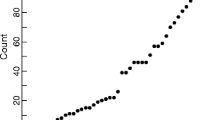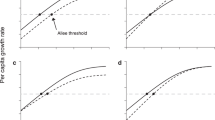Abstract
Little bustard populations have declined precipitously in many regions and countries of the western Palearctic, but they can also grow quite rapidly when conditions are favourable, reaching high densities from very low numbers in relatively few years. A few documented cases indeed indicate a marked exponential growth phase before they level off due to density-dependent effects. Population decreases also tend to be exponential rather than linear or slowly accelerated, for example when environmental conditions become adverse, which is a challenge for conservation since declines are usually faster than expected by managers, particularly in their initial stages. Thus, although the little bustard is a large and fairly long-lived bird, its capacity for fast recovery when favourable conditions are met makes the species a composite in the conceptual framework of K-r selection, showing both K- and r-selected traits. The population viability analyses (PVA) reviewed in this chapter indicate that little bustard long-term population persistence requires adult survival to be higher than 80%, fecundity higher than 0.9 fledglings per female, and sex ratio to stay between 0.3 and 0.5 males/total adult population. Population size should be also over 20 individuals, as density-dependent effects seem to be critical in little bustard population dynamics, likely in relation to lekking behaviour and constraints. For instance, a lek size below two males results in strong breeding depression, leading to increased risk of extinction in small populations due to the Allee effect. However, lekking also allows bustard populations to tolerate relatively small male numbers. PVAs further illustrate the relevance of connectivity in the species’ dynamics for both local populations and metapopulations. The latter seems to be adequately described by classic source-sink metapopulation models. Simulations also highlight the importance of guaranteeing a secure landscape matrix for dispersing birds, given the impact of mortality during the dispersal process. Little bustard population growth rates are highly sensitive to land use changes. Moreover, the impact of land management on little bustard breeding success and thus population growth may be modified by weather, particularly in Mediterranean regions. Consequently, conservation management should be adapted to forecasted climate changes.
Access this chapter
Tax calculation will be finalised at checkout
Purchases are for personal use only
Similar content being viewed by others
References
Alonso JC, Martin CA, Alonso JA, Palacin C, Magaña M, Lane SJ (2004) Distribution dynamics of a great bustard metapopulation throughout a decade: influence of conspecific attraction and recruitment. Biodivers Conserv 13:1659–1674
Badenhausser I, Amouroux P, Lerin J, Bretagnolle V (2009) Acridid (Orthoptera: Acrididae) abundance in Western European grasslands: sampling methodology and temporal fluctuations. J of Appl Entomol 133:720–732
Battin J (2004) When good animals love bad habitats: ecological traps and the conservation of animal populations. Conserv Biol 18:1482–1491
Bretagnolle V, Inchausti P (2005) Modelling population reinforcement at a large spatial scale as a conservation strategy for the declining little bustard (Tetrax tetrax) in agricultural habitats. Anim Conserv 8:59–68
Bretagnolle V, Villers A, Denonfoux L, Cornulier T, Inchausti P, Badenhausser I (2011) Rapid recovery of a depleted population of little bustards Tetrax Tetrax following provision of alfalfa through an agri-environment scheme. Ibis 153:4–13
Bretagnolle V, Denonfoux L, Villers A (2018) Are farming and birds irreconcilable? A 21-year study of bustard nesting ecology in intensive agroecosystems. Biol Conserv 228:27–35
Courchamp F, Clutton-Brock T, Grenfell B (1999) Inverse density dependence and the Allee effect. TREE 14:405–410
Dale S (2001) Female-biased, low-female recruitment, unpaired males, and the extinction of small and isolated populations. Oikos 92:344–356
De Roos AM, Persson L, McCauley E (2003) The influence of size-dependent life-history traits on the structure and dynamics of populations and communities. Ecol Lett 6:473–487
Delgado MP, Morales MB, Traba J, García de la Morena EL (2009) Determining the effects of habitat management and climate on the population trends of a declining steppe bird. Ibis 151:440–451
Delgado MP, Traba J, García de la Morena EL, Morales MB (2010) Habitat selection and density-dependent relationships in spatial occupancy by male Little Bustards Tetrax tetrax. Ardea 98:185–194
Delibes M, Ferreras P, Gaona P (2001) Attractive sinks, or how individual behavioural decisions determine source–sink dynamics. Ecol Lett 4:401–403
Devoucoux P (2014) Conséquences et impacts prévisibles d’une perte d’habitat majeure sur une espèce menacée aux exigences écologiques complexes : effets de la mise en place du contournement ferroviaire à grande vitesse Nîmes-Montpellier sur la dynamique de la population d’outarde canepetière des Costières de Nîmes. Dissertation, University of Poitiers
Donald PF, Evans AD, Muirhead LB, Buckingham DL (2002) Survival rates, causes of failure and productivity of Skylark Alauda arvensis nests on lowland farmland. Ibis 144:652–664
Faria N, Morales MB (2017) Population productivity and late breeding habitat selection by the threatened little bustard: the importance of grassland management. Bird Conserv Int. https://doi.org/10.1017/S0959270917000387
Faria N, Morales MB, Rabaca JE (2016) Exploring nest destruction and bird mortality in mown Mediterranean dry grasslands: an increasing threat to grassland bird conservation. Eur J Wildl Res 62:663–670
Fryxell JM, Sinclair ARE, Caughley G (2014) Wildlife ecology, conservation, and management, 3rd edn. Wiley, Oxford
García de la Morena EL, Bota G, Mañosa S, Morales MB (2018) El sisón común en España. II Censo Nacional (2016). SEO/Birdlife, Madrid
Grüebler MU, Schuler H, Horch P, Spaar R (2012) The effectiveness of conservation measures to enhance nest survival in a meadow bird suffering from anthropogenic nest loss. Biol Conserv 14:197–203
Hanski I (1999) Metapopulation dynamics. Oxford University Press, Oxford
Höglund J, Alatalo RV (1995) Leks. Princeton University Press, Princeton, NJ
Inchausti P, Bretagnolle V (2005) Predicting short-term extinction risk for the declining Little Bustard (Tetrax tetrax) in intensive agricultural habitats. Biol Conserv 122:375–384
Jiguet F (2002) Arthropods in diet of Little Bustards Tetrax tetrax during the breeding season in western France. Bird Study 49:105–109
Jiguet F, Bretagnolle V (2001) Courtship behaviour in a lekking species: individual variations and settlement tactics in male little bustard. Behav Process 55:107–118
Jiguet F, Bretagnolle V (2006) Manipulating lek size and composition using decoys: an experimental investigation of lek evolution models. Am Nat 168:758–768
Jiguet F, Bretagnolle V (2014) Sexy males and choosy females on exploded leks: correlates of male attractiveness in the Little Bustard. Behav Process. https://doi.org/10.1016/j.beproc.2014.01.008
Jiguet F, Ollivier D (2002) Male phenotypic repeatability in the threatened Little Bustard Tetrax tetrax: a tool to estimate turnover and dispersal. Ardea 90:43–50
Jiguet F, Arroyo B, Bretagnolle V (2000) Lek mating systems: a case study in the Little Bustard Tetrax tetrax. Behav Process 51:63–82
Jolivet C, Bretagnolle V (2002) L’outarde canepetière en France : évolution récente des populations, bilan des mesures de sauvegarde et perspectives d’avenir. Alauda 70(2002):93–96
Kershner EL, Bollinger EK (1996) Reproductive success of grassland birds at East-Central Illinois airports. Am Midl Nat 136:358–366
MacArthur RH, Wilson EO (1967) The theory of island biogeography. Princeton University Press, Princeton, NJ
Marcelino J, Moreira F, Mañosa S, Cuscó F, Morales MB, García de la Morena EL, Bota G, Palmeirim JM, Silva J (2017) Tracking data of the little bustard (Tetrax tetrax) in Iberia shows high anthropogenic mortality. Bird Conserv Int. https://doi.org/10.1017/S095927091700051X
Morales MB, Jiguet F, Arroyo B (2001) Exploded leks: what bustards can teach us. Ardeola 48:85–98
Morales MB, Bretagnolle V, Arroyo B (2005a) Viability of the endangered little bustard Tetrax tetrax population of western France. Biodivers Conserv 14:3135–3150
Morales MB, García JT, Arroyo B (2005b) Can landscape composition changes predict spatial and annual variation of little bustard male abundance? Anim Conserv 8:167–174
Morales MB, García de la Morena EL, Delgado MP, Traba J (2008a) Tendencia reciente y viabilidad futura de las poblaciones de sisón común Tetrax tetrax en la Comunidad de Madrid. Anu Ornitol Madr 11:42–55
Morales MB, Traba J, Carriles E, Delgado MP, García de la Morena EL (2008b) Sexual differences in microhabitat selection of breeding Little Bustards Tetrax tetrax: ecological segregation based on vegetation structure. Acta Oecol 34:345–353
Morales MB, Traba J, Delgado MP, García de la Morena EL (2013) The use of fallows by nesting little bustard Tetrax tetrax females: implications for conservation in mosaic cereal farmland. Ardeola 60:85–97
Morales MB, Casas F, García de la Morena EL, Ponjoan A, Calabuig G, Martínez-Padilla J, García JT, Mañosa S, Viñuela J, Bota G (2014) Density dependence and habitat quality modulate the intensity of display territory defence in an exploded lekking species. Behav Ecol Sociobiol 68:1493–1504
Newton I (1998) Population limitation in birds. Academic Press, San Diego
Pianka ER (1970) On r- and k-selection. Am Nat 104:592–597
Pinto M, Rocha P, Moreira F (2005) Long-term trends in great bustard (Otis tarda) populations in Portugal suggest concentration in single high quality area. Biol Conserv 124:415–423
Poulsen JG, Sotherton NW, Aebischer NJ (1998) Comparative nesting and feeding ecology of skylarks Alauda arvensis on arable farmland in southern England with special reference to set-aside. J Appl Ecol 35:131–147
Reid N, McDonald RA, Montgomery WI (2010) Homogeneous habitat can meet the discrete and varied resource requirements of hares but may set an ecological trap. Biol Conserv 143:1701–1706
Robertson B, Hutto R (2006) A framework for understanding ecological traps and an evaluation of existing evidence. Ecology 87:1075–1085
Silva JP, Estanque B, Moreira F, Palmeirim JM (2014) Population density and use of grasslands by female Little Bustards during lek attendance, nesting and brood-rearing. J Ornithol 155:53–63
Silva JP, Catry I, Palmeirim JM, Moreira F (2015) Freezing heat: thermally imposed constraints on the daily activity patterns of a free-ranging grassland bird. Ecosphere 6:article number 119. https://doi.org/10.1890/ES14-00454.1
Silva JP, Correia R, Alonso H, Martins RC, D’Amico M, Delgado A, Sampaio H, Godinho C, Moreira F (2018) EU protected area network did not prevent a country wide population decline in a threatened grassland bird. PeerJ 6:e4284. https://doi.org/10.7717/peerj.4284
Suvorov P, Svobodová J (2012) The occurrence of ecological traps in bird populations: is our knowledge sufficient? A review. J Landsc Ecol 5:36–56
Traba J, Morales MB (2019) The decline of farmland birds in Spain is strongly associated to the loss of fallowland. Sci Rep 9:9473. https://doi.org/10.1038/s41598-019-45854-0
Traba J, Bota G, Mañosa S, García de la Morena EL, Morales MB (2020) Análisis de viabilidad de la población de sisón común (Tetrax tetrax) en España. Anexo a la solicitud de recatalogación del sisón común en el Catálogo Español de Especies Amenazadas. Unpublished report
Villers A (2010) Ecologie spatiale, processus comportementaux et dynamiques des populations d’une espèce menacée, l’Outarde Canepetière. PhD Thesis. University of Paris 6, Paris
Wagner RH, Danchin E (2003) Conspecific copying: a general mechanism of social aggregation. Anim Behav 65:405–408
Widemo F, Owens PF (1995) Lek size, male mating skew and the evolution of lekking. Nature 373:148–151
Wolff A, Paul J, Martin JL, Bretagnolle V (2001) The benefits of extensive agriculture to birds: the case of the little bustard. J Appl Ecol 38:963–975
Acknowledgements
We are thankful to Alex Villers for reviewing and commenting on initial versions of the chapter. The comments and suggestions by Juan Traba further improved the manuscript.
Author information
Authors and Affiliations
Corresponding author
Editor information
Editors and Affiliations
Rights and permissions
Copyright information
© 2022 Springer Nature Switzerland AG
About this chapter
Cite this chapter
Morales, M.B., Bretagnolle, V. (2022). Little Bustard Population Dynamics. In: Bretagnolle, V., Traba, J., Morales, M.B. (eds) Little Bustard: Ecology and Conservation. Wildlife Research Monographs, vol 5. Springer, Cham. https://doi.org/10.1007/978-3-030-84902-3_11
Download citation
DOI: https://doi.org/10.1007/978-3-030-84902-3_11
Published:
Publisher Name: Springer, Cham
Print ISBN: 978-3-030-84901-6
Online ISBN: 978-3-030-84902-3
eBook Packages: Earth and Environmental ScienceEarth and Environmental Science (R0)




